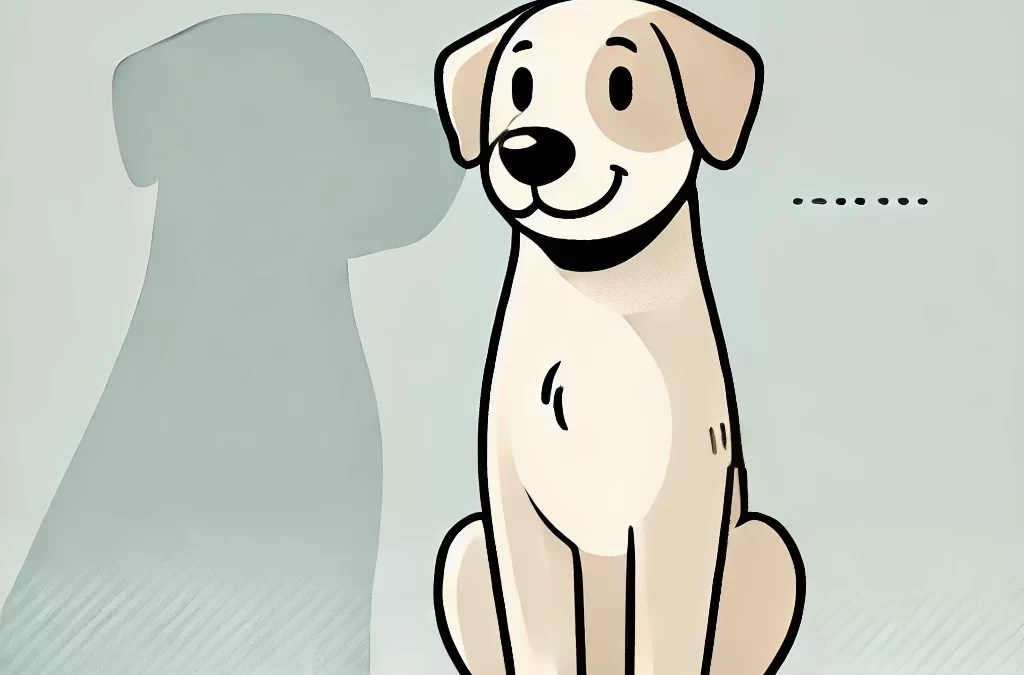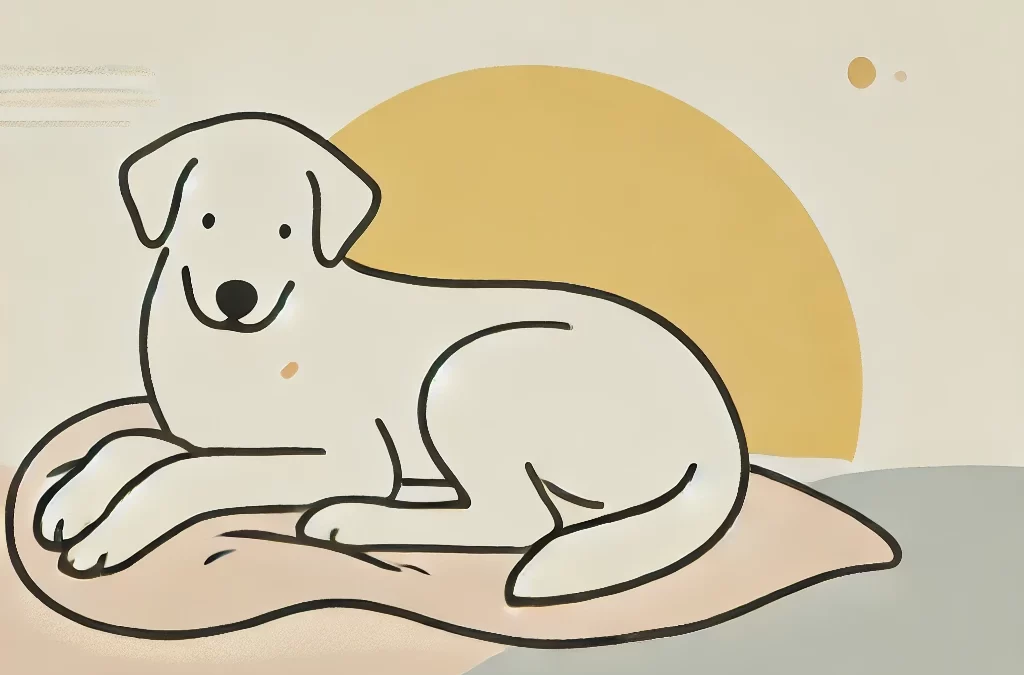
door TCMVET | 22 november 2024 | Hondenkanker en tumoren
Het vinden van een knobbel of bult bij uw hond kan een alarmerende ervaring zijn, maar niet alle gezwellen zijn gevaarlijk. Cysten komen bijvoorbeeld relatief vaak voor bij honden en zijn vaak goedaardig. De vraag rijst echter: gaat een cyste bij een hond vanzelf weg? Laten we dit probleem eens nader bekijken en de soorten, oorzaken en natuurlijke benaderingen voor het behandelen van cysten onderzoeken, evenals wanneer professionele interventie noodzakelijk is.
Wat is een cyste precies?
Een cyste is een gesloten zak gevuld met vloeistof, halfvast materiaal of lucht. Ze vormen zich vaak onder de huid en kunnen in grootte variëren. Cysten bij honden worden meestal veroorzaakt door geblokkeerde haarzakjes, trauma of infecties. Hoewel de meeste ongevaarlijk zijn, is het begrijpen van hun aard essentieel om de gezondheid van uw hond te waarborgen.
Soorten cysten bij honden
- Talgcysten: Gevolg van geblokkeerde olieklieren en zijn het meest voorkomende type. Deze verschijnen vaak als kleine, langzaam groeiende bultjes en kunnen na verloop van tijd scheuren.
- Folliculaire cysten: Gekoppeld aan verstoppingen van haarzakjes, vaak veroorzaakt door irritatie of genetica.
- Echte cysten: Deze zijn omgeven door een epitheellaag en zijn zeldzaam maar duidelijk herkenbaar.
- Abcessen: Hoewel het officieel geen cysten zijn, zijn het geïnfecteerde bulten gevuld met pus. Ze worden vaak aangezien voor cysten.
Zal het probleem zich vanzelf oplossen?
Het antwoord hangt af van het type cyste en de onderliggende oorzaak:
- Talgcysten:Deze kunnen scheuren en vanzelf leeglopen, maar ze vullen zich vaak weer, tenzij de zak volledig wordt verwijderd.
- Folliculaire cysten:Deze verdwijnen zelden zonder ingrijpen en kunnen in de loop van de tijd groter worden.
- Geïnfecteerde cysten of abcessen: Vereisen onmiddellijke behandeling om complicaties te voorkomen. Ze genezen niet vanzelf.
Hoewel sommige cysten tijdelijk kleiner kunnen worden, is het ongebruikelijk dat ze vanzelf helemaal verdwijnen.
Natuurlijke benaderingen voor het behandelen van cysten
Als de cyste klein is, niet pijnlijk is en uw dierenarts heeft bevestigd dat deze goedaardig is, kan een natuurlijke behandeling worden overwogen. Deze remedies zijn gericht op het verminderen van ontstekingen, het voorkomen van infecties en het bevorderen van de gezondheid van de huid:
1. Warm kompres
Een warm kompres kan de bloedstroom naar het gebied stimuleren, waardoor de cyste op natuurlijke wijze kan weglopen. Gebruik een schone doek gedrenkt in warm water en leg deze voorzichtig 5-10 minuten lang, tweemaal daags.
2. Kurkumapasta
De ontstekingsremmende en antimicrobiële eigenschappen van kurkuma maken het een favoriet in holistische huisdierverzorging. Meng kurkumapoeder met kokosolie tot een pasta en breng het aan op de cyste (met goedkeuring van de dierenarts).
3. Ricinusolie
Rijk aan ricinolzuur, kan ricinusolie helpen ontstekingen te verminderen. Dep een kleine hoeveelheid op de cyste met een wattenstaafje.
4. Dieetaanpassingen
Het dieet van uw hond versterken met omega-3-vetzuren (visolie) en antioxidanten kan de algehele gezondheid van de huid verbeteren. Zorg ervoor dat hun dieet rijk is aan vitamine E en C om weefselherstel te ondersteunen.
5. Kruidenremedies
Calendula- en kamillekompressen hebben een verzachtende werking en kunnen het genezingsproces bevorderen.
Wanneer moet u een dierenarts raadplegen?
Hoewel natuurlijke remedies effectief kunnen zijn bij de behandeling van kleine, goedaardige cysten, vereisen sommige situaties professionele aandacht:
- Snelle groei:Als de cyste snel groter wordt, kan dit duiden op een onderliggend probleem.
- Pijn of ongemak: Als uw hond pijn vertoont, aanrakingen vermijdt of de plek obsessief likt.
- Infection:Roodheid, zwelling, warmte of etterende pus zijn tekenen van een geïnfecteerde cyste.
- Meerdere klonten: Kan duiden op een systemisch probleem of een andere aandoening.
- Locatieproblemen: Cysten in de buurt van gewrichten of vitale organen moeten zo snel mogelijk worden onderzocht.
Een evenwichtige aanpak: natuur en wetenschap combineren
Een hondencyste, hoewel vaak ongevaarlijk, vereist zorgvuldige observatie. Door natuurlijke remedies te combineren met veterinaire begeleiding, verzekert u het comfort en de veiligheid van uw hond. Vergeet niet dat cysten zelden helemaal vanzelf verdwijnen, dus proactieve zorg is essentieel.
De conclusie? Raak niet in paniek als u een cyste bij uw hond ontdekt. Houd in plaats daarvan de grootte en het gedrag in de gaten, gebruik indien nodig natuurlijke therapieën en raadpleeg uw dierenarts om ernstigere aandoeningen uit te sluiten. Door een evenwichtige en geïnformeerde aanpak te hanteren, kunt u uw harige vriend gezond, gelukkig en bloeiend houden.

door TCMVET | 22 november 2024 | Hondenkanker en tumoren
Osteosarcoom, een type botkanker, is een uitdagende diagnose voor hondenbezitters. Hoewel conventionele behandelingen zoals amputatie en chemotherapie de levensverwachting kunnen verbeteren, zoeken velen naar natuurlijke therapieën om de kwaliteit van leven van hun huisdieren te ondersteunen. Een evenwichtige aanpak die conventionele methoden combineert met natuurlijke behandelingen kan hoop en troost bieden aan honden met osteosarcoom. Laten we innovatieve, holistische strategieën verkennen die verder gaan dan het conventionele.
1. Voedingsondersteuning: de basis van genezing
Voeding speelt een cruciale rol bij het behandelen van osteosarcoom. Een dieet dat is afgestemd op het bestrijden van ontstekingen en het ondersteunen van de immuniteit kan een groot verschil maken.
- Hoogwaardige eiwitten: Zorgt voor spierbehoud en bestrijdt gewichtsverlies. Bronnen zijn onder andere mager vlees, vis en eieren.
- Omega-3 vetzuren: Deze stoffen komen voor in visolie, verminderen ontstekingen en kunnen de voortgang van kanker vertragen.
- Koolhydraatarm dieet: Kankercellen gedijen op glucose. Kies voor een dieet dat rijk is aan groenten zoals spinazie en broccoli, maar vermijd granen en zetmeelrijke groenten.
Tip:Botenbouillon, rijk aan collageen en aminozuren, verzacht de gewrichten en voedt op milde wijze.
2. Kruidenbondgenoten in de strijd
Natuurlijke kruiden kunnen de behandeling van kanker ondersteunen door ontstekingen aan te pakken, de immuniteit te versterken en mogelijk de groei van tumoren te vertragen.
- Kurkuma (curcumine): Bekend om zijn ontstekingsremmende en antikanker eigenschappen. Kurkuma combineren met zwarte peper verbetert de absorptie.
- Chuanxiong (Szechuan-lavas): Een kruid uit de traditionele Chinese geneeskunde, waarvan men gelooft dat het de bloedsomloop ondersteunt en tumorgerelateerd ongemak vermindert.
- Essiac-thee: Een mix van kruiden, waaronder kliswortel en rode iep, vaak gebruikt om de ontgifting en de gezondheid van het immuunsysteem te bevorderen.
Raadpleeg altijd een dierenarts die is opgeleid in kruidengeneeskunde om de veiligheid en de juiste dosering te garanderen.
3. Gerichte supplementen voor cellulaire ondersteuning
Supplementen kunnen een bondgenoot zijn in de strijd tegen de gevolgen van kanker en in het verbeteren van de algehele gezondheid.
- CBD-olie: CBD-olie staat bekend om de pijnstillende en mogelijke antikankerwerking. Het kan de mobiliteit verbeteren en angst verminderen bij honden met osteosarcoom.
- Medicinale Paddestoelen: Soorten zoals kalkoenstaart en reishi versterken de immuniteit en bevatten stoffen die de groei van tumoren kunnen remmen.
- Boswellia Serrata: Een ontstekingsremmer die pijn kan verlichten en de gezondheid van de gewrichten kan ondersteunen.
Opmerking: Kies altijd supplementen die door een dierenarts zijn goedgekeurd en controleer de kwaliteit van de ingrediënten.
4. Fysiek en emotioneel welzijn
- Acupunctuur en massage:Acupunctuur kan helpen bij het verlichten van pijn, terwijl zachte massage de bloedsomloop verbetert en stijfheid vermindert.
- Matige lichaamsbeweging: Pas de activiteiten aan op de mogelijkheden van uw hond en concentreer u op oefeningen met een lage impact, zoals zwemmen.
- Emotionele steun: Comfort en liefde spelen een cruciale rol in het genezingsproces van een hond. Besteed quality time, speel rustig en zorg voor een stressvrije omgeving.
5. Opkomende therapieën in de natuurlijke sfeer
Innovatieve benaderingen verleggen de grenzen van natuurlijke behandelingen voor osteosarcoom bij honden:
- Hyperbare zuurstoftherapie (HBOT): Verhoogt het zuurstofgehalte in het lichaam, wat de groei van tumoren kan vertragen en genezing kan bevorderen.
- Fotodynamische therapie (PDT): Maakt gebruik van lichtgevoelige verbindingen en lasertechnologie om tumoren niet-invasief aan te pakken.
- Peptide-gebaseerde therapieën:Deze innovatieve supplementen stimuleren de natuurlijke genezingsprocessen van het lichaam op cellulair niveau.
6. Een alomvattend plan op maat maken
Elke hond is uniek, en dat geldt ook voor hun behandelplan. Het combineren van natuurlijke en conventionele therapieën vereist voortdurende communicatie met uw dierenarts. Holistische dierenartsen die zijn opgeleid in integratieve geneeskunde kunnen persoonlijke begeleiding bieden.
Een oprechte herinnering
Hoewel natuurlijke behandelingen ondersteuning bieden, zijn ze het meest effectief als ze samen met conventionele therapieën worden gebruikt. Het doel is niet alleen om het leven te verlengen, maar ook om een hoge kwaliteit van leven voor uw geliefde huisdier te garanderen. Met een meelevende en geïnformeerde benadering kunt u uw hond comfort, zorg en liefde bieden tijdens deze uitdagende reis.
Door moderne inzichten te integreren met beproefde natuurlijke remedies, geeft u uw hond de beste kans op een leven vol vreugde en waardigheid. Samen kunnen we opnieuw definiëren hoe genezing eruitziet voor honden met osteosarcoom.

door TCMVET | 21 november 2024 | Hondenkanker en tumoren
Als het gaat om het behandelen van mastceltumoren bij honden, moeten eigenaren vaak een zee van behandelingsopties doorkruisen. Van deze opties heeft cimetidine, een medicijn dat oorspronkelijk is ontwikkeld om zweren te behandelen, aandacht gekregen vanwege het potentieel om de symptomen en de progressie van deze complexe aandoening te behandelen. Maar wat is precies de rol ervan en hoe beïnvloedt de dosering de effectiviteit ervan? Laten we met een frisse blik op het onderwerp duiken.
Wat is Cimetidine?
Cimetidine behoort tot een klasse medicijnen die bekend staan als H2-receptorantagonisten, die zijn ontworpen om de productie van maagzuur te verminderen. Hoewel het primair wordt gebruikt voor gastro-intestinale aandoeningen, hebben onderzoekers aanvullende voordelen ontdekt die het gebruik ervan uitbreiden naar het behandelen van mastceltumoren bij honden.
De connectie ligt in histamine. Mastceltumoren geven histamine af, wat kan leiden tot verschillende symptomen, waaronder maagzweren en ontstekingen. Door H2-receptoren te blokkeren, kan cimetidine helpen deze effecten te verzachten.
Waarom Cimetidine gebruiken bij mestceltumoren?
- Symptoombeheer:Cimetidine vermindert de afgifte van histamine, waardoor symptomen als braken, diarree en ongemak veroorzaakt door een verhoogde zuurgraad in de maag worden verminderd.
- Tumorstabilisatie: Sommige onderzoeken suggereren dat cimetidine de tumorgroei kan vertragen door de micro-omgeving van de tumor te veranderen. Dit effect wordt echter nog onderzocht.
- Ondersteunende rolCimetidine wordt vaak gebruikt als onderdeel van een multimodale aanpak, ter aanvulling van behandelingen zoals chirurgie, chemotherapie of natuurlijke therapieën.
Dosering: de juiste balans vinden
Het bepalen van de juiste dosering is cruciaal om het gewenste therapeutische effect te bereiken. Een 'one-size-fits-all'-aanpak werkt echter niet als het om honden gaat, aangezien factoren zoals grootte, leeftijd en algehele gezondheid de dosering aanzienlijk beïnvloeden.
- Algemene richtlijnen:Cimetidine wordt gewoonlijk oraal toegediend in doses variërend van 5 tot 10 mg per kilogram (2,2 lbs) van het lichaamsgewicht, twee tot drie keer per dag. Volg echter altijd de specifieke aanbevelingen van uw dierenarts.
- Op maat gemaakte dosering: Doseringen kunnen variëren op basis van de ernst van de symptomen, het stadium van de tumor en of de hond aanvullende behandelingen krijgt. Aanpassingen zijn gebruikelijk en moeten worden geleid door regelmatige monitoring.
Het belang van toezicht door een dierenarts
Hoewel cimetidine relatief veilig is, is het niet zonder bijwerkingen. Mogelijke problemen zijn diarree, lethargie of veranderingen in eetlust. Bovendien moeten interacties met andere medicijnen zorgvuldig worden overwogen, vooral als uw hond chemotherapie ondergaat of andere medicijnen gebruikt, zoals NSAID's.
Veterinair toezicht zorgt voor:
- Nauwkeurige dosering.
- Controle op bijwerkingen of interacties.
- Aanpassingen op basis van de reactie van de hond.
Alternatieve en complementaire therapieën
Hoewel cimetidine een effectief hulpmiddel is, is het vaak het meest succesvol in combinatie met andere therapieën. Enkele alternatieven zijn:
- Natuurlijke supplementen:Kruiden zoals Chuanxiong (Szechuan-lavas) of kurkuma kunnen ontstekingsremmende voordelen bieden en het algemene welzijn ondersteunen.
- Dieetaanpassingen:Een histaminearm dieet kan de effecten van cimetidine aanvullen en de vrijgave van histamine die door bepaalde voedingsmiddelen wordt veroorzaakt, verminderen.
- Holistische zorg:Acupunctuur, CBD-olie en andere ondersteunende therapieën kunnen de kwaliteit van leven van honden met mestceltumoren verbeteren.
Toekomstige innovaties in het beheer van mestceltumoren
Opkomend onderzoek blijft de rol van cimetidine en vergelijkbare medicijnen in veterinaire oncologie onderzoeken. Van gerichte therapieën tot histamineremmers, de toekomst van de behandeling van mastceltumoren bij honden biedt perspectief voor meer gepersonaliseerde en effectieve oplossingen.
Belangrijkste punten
Cimetidine is een waardevolle bondgenoot bij het behandelen van mastceltumoren, maar de effectiviteit ervan hangt af van het juiste gebruik en de integratie in een breder behandelplan. Door nauw samen te werken met uw dierenarts en op de hoogte te blijven van nieuwe ontwikkelingen, kunt u uw hond de beste kans geven op een comfortabel en gelukkig leven.
Afsluitende gedachten
Als bij uw hond mastceltumoren zijn vastgesteld, aarzel dan niet om alle beschikbare opties te verkennen. Hoewel cimetidine misschien geen genezing biedt, is het vermogen om symptomen te beheersen en de algehele behandeling te ondersteunen een belangrijk onderdeel van de puzzel. Met op maat gemaakte zorg en een holistische benadering kan uw harige vriend ondanks de uitdagingen blijven floreren.

door TCMVET | 21 november 2024 | Hondenkanker en tumoren
Wanneer een geliefde hond gezondheidsproblemen heeft, wenden huisdiereigenaren zich vaak tot moderne diagnostiek om het probleem te ontdekken. Onder deze is echografie een veelgebruikt hulpmiddel geworden voor dierenartsen. Maar hoe effectief is het bij het detecteren van kanker bij honden? Laten we deze vraag diepgaand onderzoeken en zowel de sterke als de zwakke punten van deze technologie onderzoeken.
De basisprincipes van echografie in de diergeneeskunde
Echografie, ook wel bekend als sonografie, maakt gebruik van geluidsgolven om realtime beelden te maken van de interne organen van een hond. Het is vooral handig voor het onderzoeken van zachte weefsels, zoals de lever, nieren, milt en blaas. In tegenstelling tot röntgenfoto's, die een statisch beeld bieden, biedt echografie dynamische beelden, waardoor dierenartsen de orgaanfunctie kunnen beoordelen en afwijkingen kunnen detecteren.
Hoe echografie kanker detecteert
Echografie kan helpen bij het identificeren van tumoren, abnormale weefselgroei of onregelmatige orgaanstructuren die op kanker kunnen duiden. Bijvoorbeeld:
- Tumoren lokaliseren: Met echografie kunnen de grootte, vorm en locatie van massa's worden onthuld. Dit is vooral nuttig bij kankers in de buik, zoals lever- of niertumoren.
- Begeleiden van biopsieën:Hoewel echografie geen definitieve diagnose van kanker kan stellen, speelt het een belangrijke rol bij het begeleiden van naaldbiopsieën om weefselmonsters te nemen voor laboratoriumanalyse.
- Monitoring van de voortgang:Voor honden die een kankerbehandeling ondergaan, is echografie een waardevol hulpmiddel om te monitoren hoe de ziekte reageert op therapieën.
De beperkingen van echografie bij kankerdetectie
Ondanks de voordelen heeft echografie ook bepaalde beperkingen:
- Kan kanker niet bevestigen: Met echografie kunnen massa's worden geïdentificeerd, maar niet worden vastgesteld of ze kwaadaardig (kankerachtig) of goedaardig (niet-kankerachtig) zijn. Een biopsie of geavanceerde beeldvorming, zoals MRI- of CT-scans, is meestal vereist voor bevestiging.
- Operatorafhankelijkheid: De nauwkeurigheid van echografie hangt af van de vaardigheid en ervaring van de dierenarts. Verkeerde interpretatie van beelden kan leiden tot vals-positieve of -negatieve resultaten.
- Niet geschikt voor alle vormen van kanker: Ultrageluid is minder effectief voor het detecteren van kanker in botten, longen of gebieden met dichte structuren. In dergelijke gevallen zijn andere beeldvormingstechnieken geschikter.
Wanneer u echografie voor uw hond moet overwegen
Als uw hond symptomen vertoont zoals onverklaarbaar gewichtsverlies, braken, zwelling of lethargie, kan uw dierenarts een echo aanbevelen als onderdeel van het diagnostische proces. Het is een niet-invasieve, pijnloze procedure met minimaal risico, waardoor het in veel gevallen een voorkeurseerste stap is.
Toekomstige innovaties: Verbetering van de kankerdetectiecapaciteiten van echografie
Vooruitgang in de diergeneeskunde verbetert voortdurend de echografietechnologie. Technieken zoals contrastversterkte echografie en elastografie komen naar voren als veelbelovende hulpmiddelen voor het beter identificeren van kankerweefsel. Deze innovaties kunnen echografie binnenkort nauwkeuriger maken bij het onderscheiden van kwaadaardige van goedaardige gezwellen.
Een evenwichtige benadering van kankerdiagnose
Hoewel echografie een krachtig diagnostisch hulpmiddel is, werkt het het beste als onderdeel van een uitgebreide diagnostische aanpak. Door echografie te combineren met andere technieken, zoals bloedonderzoeken, biopsieën en geavanceerde beeldvorming, wordt de meest nauwkeurige diagnose en het meest effectieve behandelplan voor uw hond gegarandeerd.
Laatste gedachten
Echografie is een onmisbaar hulpmiddel in de diergeneeskunde en biedt waardevolle inzichten in de gezondheid van een hond. Hoewel het zijn beperkingen heeft, speelt het een cruciale rol bij het detecteren en behandelen van kanker. Door op de hoogte te blijven en nauw samen te werken met uw dierenarts, kunt u ervoor zorgen dat uw harige metgezel de best mogelijke zorg krijgt, zelfs bij uitdagende diagnoses.
4o

door TCMVET | 20 november 2024 | Voedsel & Gezondheid
Naarmate meer huisdiereigenaren op zoek gaan naar innovatieve oplossingen om het leven van hun aan kanker lijdende honden te verbeteren, N-acetylcysteïne (NAC) is naar voren gekomen als een potentiële game-changer. NAC staat bekend om zijn antioxiderende en ontgiftende eigenschappen en trekt aandacht als een aanvullende therapie in de strijd tegen kanker bij honden. Maar wat maakt deze verbinding zo speciaal en hoe kan het de kankerzorg voor uw harige vriend transformeren? Laten we eens duiken in deze baanbrekende aanpak.
Wat is NAC?
N-acetylcysteïne (NAC) is een derivaat van het aminozuur cysteïne. NAC wordt veel gebruikt in de humane geneeskunde voor aandoeningen zoals paracetamolvergiftiging, chronische ademhalingsproblemen en leverondersteuning. Het vermogen van NAC om de glutathionspiegels (een belangrijke antioxidant in het lichaam) aan te vullen, maakt het van onschatbare waarde. Bij honden vertaalt dit zich in verbeterde cellulaire bescherming en de vermindering van oxidatieve stress, belangrijke factoren in de progressie van kanker.
De wetenschap achter NAC en kanker
Kanker gedijt in omgevingen met chronische ontstekingen en oxidatieve schade. De dubbele rol van NAC als antioxidant en ontstekingsremmer pakt deze grondoorzaken aan, waardoor tumorgroei mogelijk wordt vertraagd en de algehele gezondheid wordt verbeterd. Zo kan NAC honden met kanker ondersteunen:
- Glutathionniveaus verhogen
Glutathion is cruciaal voor het ontgiften van cellen en het bestrijden van oxidatieve stress. Honden met kanker hebben vaak een verlaagd glutathiongehalte, waardoor ze kwetsbaar zijn voor verdere cellulaire schade. NAC fungeert als een voorloper, herstelt deze gehaltes en beschermt gezonde cellen.
- Reducing Inflammation
Chronische ontstekingen voeden de ontwikkeling van kanker. De ontstekingsremmende effecten van NAC kunnen deze vicieuze cirkel verstoren en zo de tumorprogressie beperken.
- Ondersteuning van chemotherapie en bestraling
Kankerbehandelingen beschadigen vaak gezonde cellen samen met kankercellen. NAC helpt normale cellen te beschermen, vermindert bijwerkingen en verbetert herstel.
- Het remmen van tumorgroei
Uit onderzoek is gebleken dat NAC de processen kan verstoren die de proliferatie van tumorcellen bevorderen. Hierdoor zou het een potentieel direct middel kunnen zijn tegen kanker.
- Verbetering van de immuunfunctie
Een sterk immuunsysteem is cruciaal in de strijd tegen kanker. Door oxidatieve stress te verminderen, helpt NAC immuuncellen effectiever te functioneren.
Hoe NAC te gebruiken voor honden met kanker
Wanneer u NAC opneemt in het kankerzorgplan van uw hond, is het essentieel om dit te doen onder begeleiding van een dierenarts. Hier is waar u rekening mee moet houden:
- Dosering: De juiste dosering hangt af van de grootte van uw hond, zijn algehele gezondheid en specifieke behoeften. Raadpleeg altijd uw dierenarts voor persoonlijke aanbevelingen.
- Formulier: NAC is verkrijgbaar in capsules, poeders en injecteerbare vormen. Orale supplementen zijn de meest voorkomende optie voor honden.
- Complementaire therapieën:NAC werkt het beste als onderdeel van een holistische benadering, met inbegrip van een voedingsrijk dieet, regelmatige lichaamsbeweging en andere ondersteunende therapieën.
Voordelen die verder gaan dan kanker
Hoewel NAC voornamelijk wordt besproken vanwege de kankergerelateerde voordelen, biedt het ook andere gezondheidsvoordelen voor honden:
- Bescherming van de leverfunctie tijdens chemotherapie
- Ondersteuning van de gezondheid van de luchtwegen door slijm te verdunnen bij aandoeningen zoals bronchitis
- Het bevorderen van herstel na infecties of immuun-ondermijnende aandoeningen
Voorzorgsmaatregelen en bijwerkingen
Hoewel NAC over het algemeen goed wordt verdragen, is het belangrijk om te letten op bijwerkingen, zoals maag-darmklachten of allergische reacties. Bovendien kunnen de antioxiderende eigenschappen van NAC interfereren met bepaalde chemotherapiemedicijnen, dus timing en coördinatie met uw dierenarts zijn cruciaal.
Een holistische visie op kankerzorg
De toekomst van kankerzorg voor honden ligt in integrale benaderingen die traditionele behandelingen combineren met wetenschappelijk onderbouwde natuurlijke therapieën zoals NAC. Door de grondoorzaken van kanker aan te pakken en de algehele gezondheid te ondersteunen, biedt NAC hoop op een betere kwaliteit van leven en mogelijk verbeterde resultaten.
Deze revolutionaire stof belooft geen wonderen, maar het opent wel de deur naar een nieuwe manier van denken over kankerbehandelingen, waarbij het welzijn van uw hond op elk niveau voorop staat.
Laatste gedachten
Naarmate meer onderzoek het potentieel van NAC blootlegt, blijft de rol ervan in de zorg voor honden met kanker groeien. Voor huisdiereigenaren die op zoek zijn naar innovatieve manieren om hun harige metgezellen te ondersteunen, is NAC een baken van hoop. Met de juiste begeleiding en een holistische benadering kan het net het ontbrekende stukje zijn in de strijd van uw hond tegen kanker.





